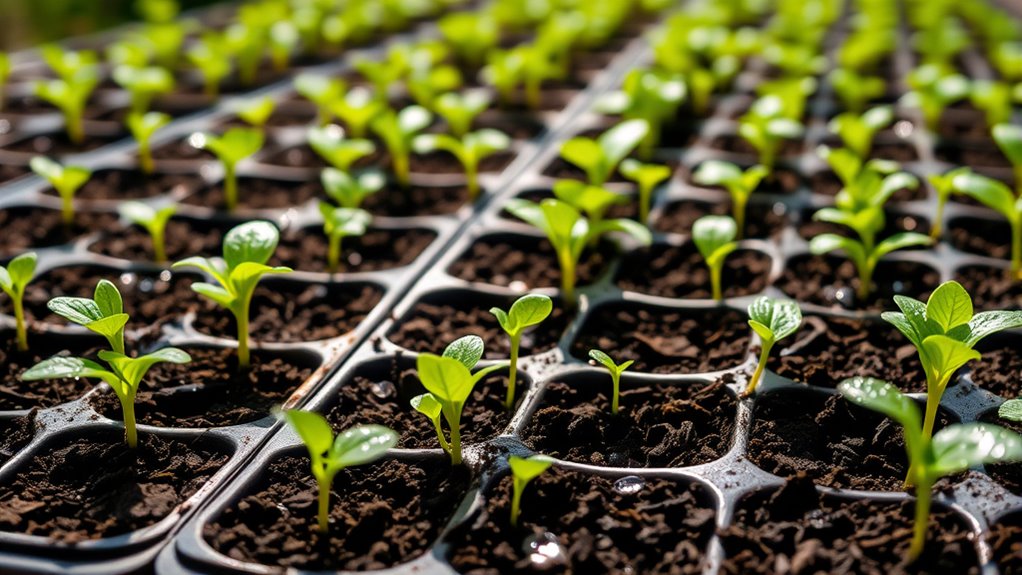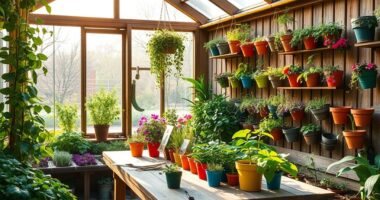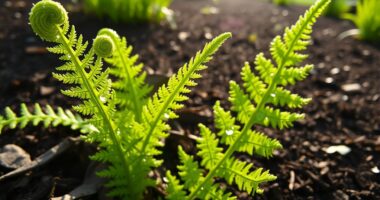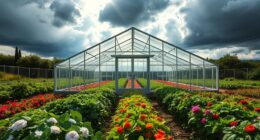When I started my garden, finding the right seed trays transformed my planting experience. I recommend looking for options like the Apipi 72 Cell Trays or Epic Gardening's reusable trays, which are designed for durability and effective drainage. A good seed tray promotes healthy seedlings with proper airflow and moisture management. You'll want trays that are reusable and easy to store too. Stick around, and I'll share more insights on choosing the best seed trays for your garden!
Key Takeaways
- Select seed trays with effective drainage systems to prevent waterlogging and promote healthy root growth.
- Opt for durable, reusable materials like BPA-free plastic for long-lasting use across multiple planting seasons.
- Choose trays with appropriate cell sizes and capacities to maximize seed variety and starting efficiency.
- Look for designs with adjustable airflow and humidity management features to optimize seedling health.
- Utilize organizational tools, such as labels and dibbers, for easy identification and management of seedlings.
Apipi Seed Starter Tray – 10 Pcs 72 Cell Reusable Seedling Nursery Trays
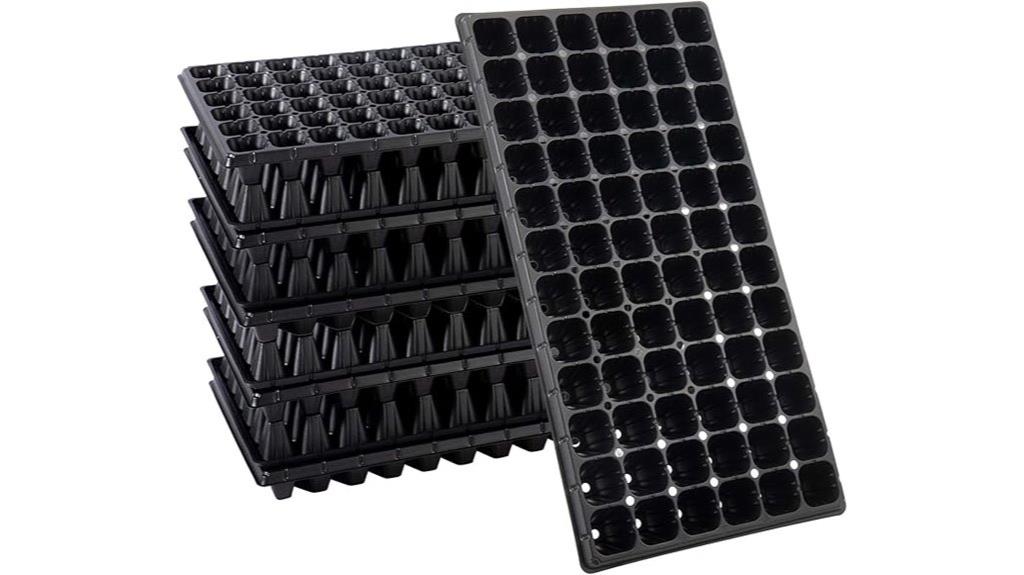
If you're looking to give your seedlings the best start, the Apipi Seed Starter Tray is a fantastic choice, especially for gardeners who need a reliable and efficient way to nurture a variety of plants. With 10 trays featuring 72 cells each, I found their 1.5-inch diameter perfect for small plants. The independent growth space prevents root entanglement, and the tilting cell walls help with drainage, reducing the risk of over-watering. Made from durable, BPA-free plastic, these trays can last for years. Just keep in mind, you might want to grab a separate drain tray for ideal results!
Best For: Gardeners looking for a reliable and efficient seedling nursery solution for flowers, vegetables, herbs, and fruits.
Pros:
- Independent growth spaces prevent root entanglement, promoting healthier plants.
- Durable, BPA-free plastic ensures long-lasting use with proper care.
- Designed for efficient drainage with tilting cell walls and bottom drain holes.
Cons:
- Some users report flexibility issues, requiring two hands to move the trays.
- Cells may not fit perfectly in 1020 trays, with some curving upwards.
- Mixed reviews on thickness; some find them flimsy compared to others.
SOLIGT Extra Thick Heavy Duty Seed Starting Trays (10 Pack)
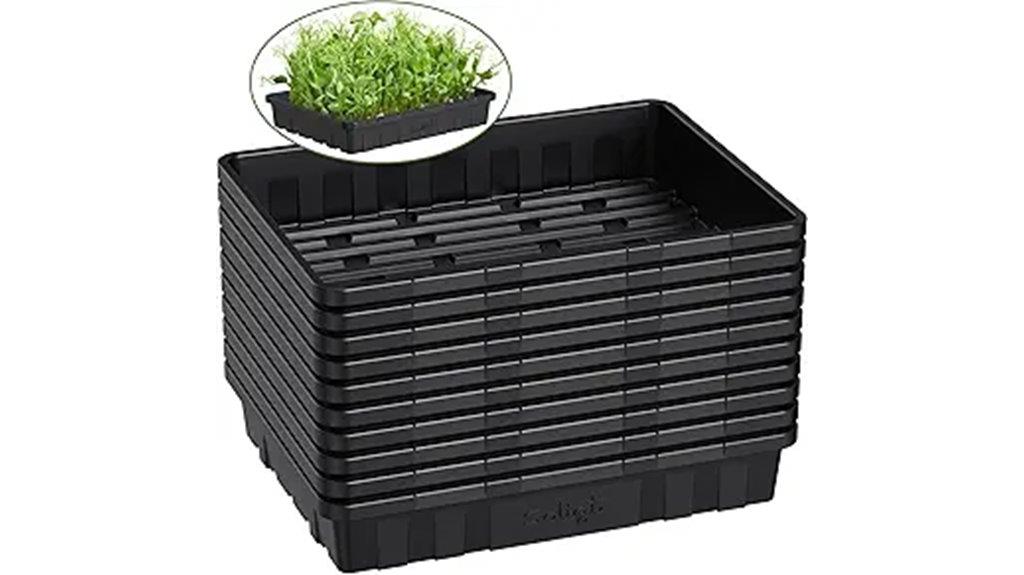
The SOLIGT Extra Thick Heavy Duty Seed Starting Trays are perfect for dedicated gardeners who want to maximize their seed starting success. These trays, measuring 14 by 10.8 inches, feature a no-leak design that prevents overwatering while promoting healthy root absorption through bottom watering. I love how their heavy-duty material holds up under the weight of growing plants without buckling. They're reusable, saving me the hassle of frequent replacements. Plus, they fit seamlessly into various gardening setups, from indoor gardens to greenhouses. Overall, I've found them incredibly durable and effective, making my gardening experience a lot smoother.
Best For: Dedicated gardeners looking to maximize seed starting success with a durable and reusable tray option.
Pros:
- Durable Material: Heavy-duty design that can support the weight of growing plants without buckling.
- No Leak Design: Prevents overwatering and allows for effective bottom watering for better root absorption.
- Versatile Use: Suitable for various gardening setups, including indoor gardens, greenhouses, and hydroponics.
Cons:
- Storage Issues: Some users may find difficulty fitting standard trays inside due to depth.
- Bulkiness: The trays can be heavier and bulkier compared to lighter alternatives, making them less portable.
- Learning Curve: New gardeners may need time to adjust to the bottom watering technique effectively.
Self-Watering Seed Starter Tray with Grow Light

For anyone looking to nurture their indoor plants from seed to sprout, the self-watering seed starter tray with grow light is an ideal choice. This 60-cell tray comes with a humidity dome and a self-watering system that keeps moisture consistent without overwatering. The pro grow lights, featuring 56 high-efficiency beads, mimic natural sunlight, promoting faster growth. I love the adjustable brightness and timer, allowing me to cater to my plants' needs at every stage. Made from durable, BPA-free materials, it's easy to set up and maintain, making it perfect for beginners. Trust me, it's a game changer for indoor gardening!
Best For: Indoor gardening enthusiasts and beginners looking to easily start seeds and nurture plants efficiently.
Pros:
- Adjustable brightness and timer features for customized growth conditions.
- Self-watering system prevents overwatering and maintains consistent moisture.
- Durable, BPA-free materials ensure longevity and effective temperature and humidity control.
Cons:
- Timer is limited to 12 hours, which may not suit all plant needs.
- Replacement trays can be difficult to find.
- Some users may find the setup process a bit complex initially.
4 Packs Medium Seed Starter Tray with Adjustable Brightness and Timer
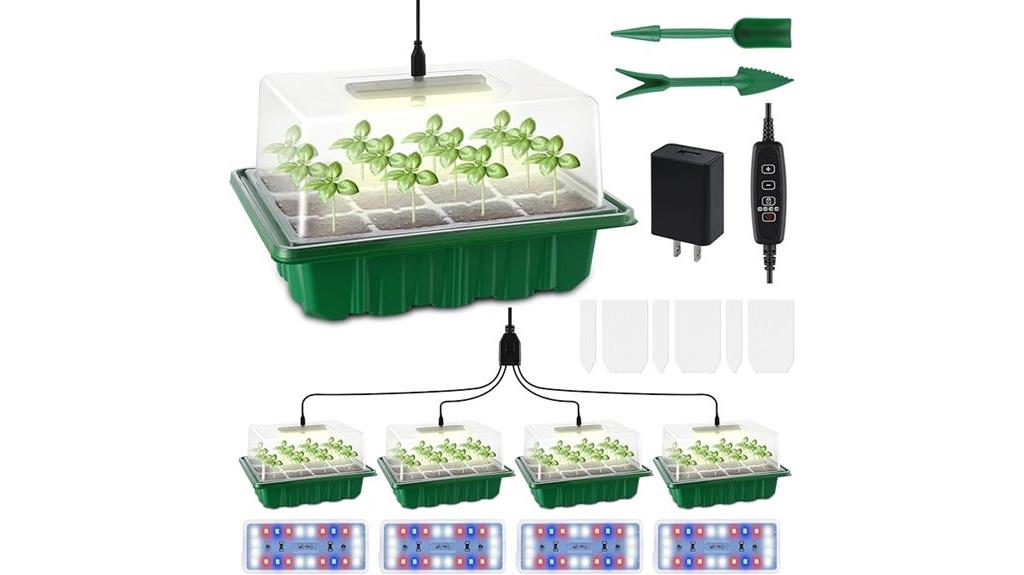
Looking for an efficient way to start your seeds? The Packs Medium Seed Starter Tray with Adjustable Brightness and Timer is a game changer! With 24 full-spectrum LEDs, it mimics natural sunlight, optimizing growth and photosynthesis. You can easily customize the brightness and set lighting schedules with four, eight, twelve, or eighteen-hour cycles. Plus, it features an auto-humidity control dome that guarantees moisture management. This kit includes handy tools like a seedling dibber and labels for organization. At just 2.38 pounds, it's lightweight and perfect for indoor or outdoor use. You'll love how easy it is to grow thriving plants!
Best For: Gardening enthusiasts looking for an efficient and user-friendly solution to start seeds indoors or outdoors.
Pros:
- Customizable lighting schedules with adjustable brightness to meet specific plant needs.
- Includes essential tools like a seedling dibber and labels for better organization and ease of use.
- Lightweight and portable design makes it suitable for various growing environments.
Cons:
- Limited to medium-sized seedlings, which may not accommodate larger plants.
- Requires a power source for the LED lights, which may limit placement options.
- Some users may need to purchase heat mats separately for optimal growth in colder climates.
Burpee SuperSeed Seed Starting Tray (36 Cell Reusable)
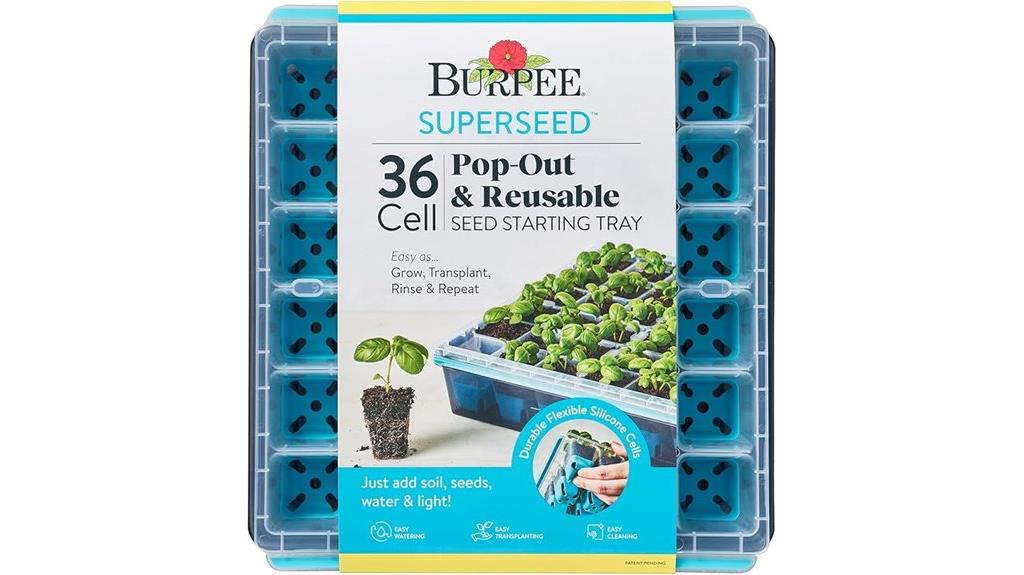
With 36 flexible pop-out cells, the Burpee SuperSeed Seed Starting Tray is perfect for anyone enthusiastic to cultivate a vibrant indoor garden. Measuring 11.5 x 10-3/8 x 2-1/4 inches, it fits nicely in limited spaces. I love how the molded corner slots enhance drainage and prevent overwatering, while the soft silicone cells reduce stress when transplanting. Plus, it's dishwasher safe and reusable for multiple seasons! The Plant-o-Gram diagram helps identify seedlings, but I wish it included labels. Overall, this tray offers excellent germination rates and is a cost-effective choice for both beginners and seasoned gardeners.
Best For: The Burpee SuperSeed Seed Starting Tray is best for beginner and experienced gardeners looking for a reliable and eco-friendly solution for indoor seed starting.
Pros:
- Excellent germination rates for a variety of seeds.
- Flexible silicone cells reduce transplant stress and are easy to clean.
- Reusable design saves money and is environmentally friendly.
Cons:
- Some users have reported durability issues with the lid.
- Lack of labels for cell identification can be inconvenient.
- May not fit larger seed varieties comfortably.
Gardzen 5-Set Seed Starter Tray Kits for Indoor Gardening
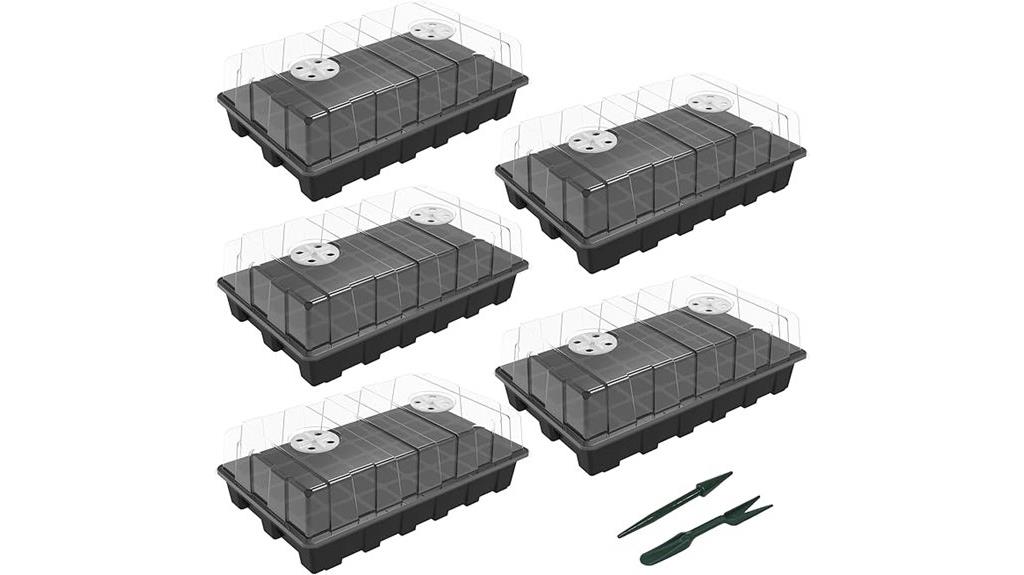
The Gardzen 5-Set Seed Starter Tray Kits are perfect for indoor gardeners seeking an efficient way to cultivate a variety of plants. With 10 trays featuring 40 cells each, you get 400 growing spaces for vegetables, flowers, and herbs. I love the durable plastic construction, which guarantees they last for years. The adjustable ventilation and clear dome let me monitor my seedlings while maintaining the right humidity. Plus, the drainage system prevents overwatering. While some users mentioned concerns about dome height and brittleness with sun exposure, I've found them effective and cost-efficient for my indoor gardening needs.
Best For: Indoor gardeners looking for an efficient and cost-effective way to start seeds and propagate various plants.
Pros:
- Durable plastic construction ensures long-lasting use and the ability to reuse over multiple seasons.
- Adjustable ventilation and clear dome design promote optimal humidity and airflow for seed growth.
- Effective drainage system prevents overwatering, making it easy to manage water levels.
Cons:
- Dome height limitations may restrict the duration seedlings can remain in the trays.
- Some users reported brittleness after prolonged sun exposure, suggesting limited outdoor use.
- Transparency of the cell trays can hinder effective monitoring of root growth.
Hydroponic City Seed Starter Trays (216-Cell)
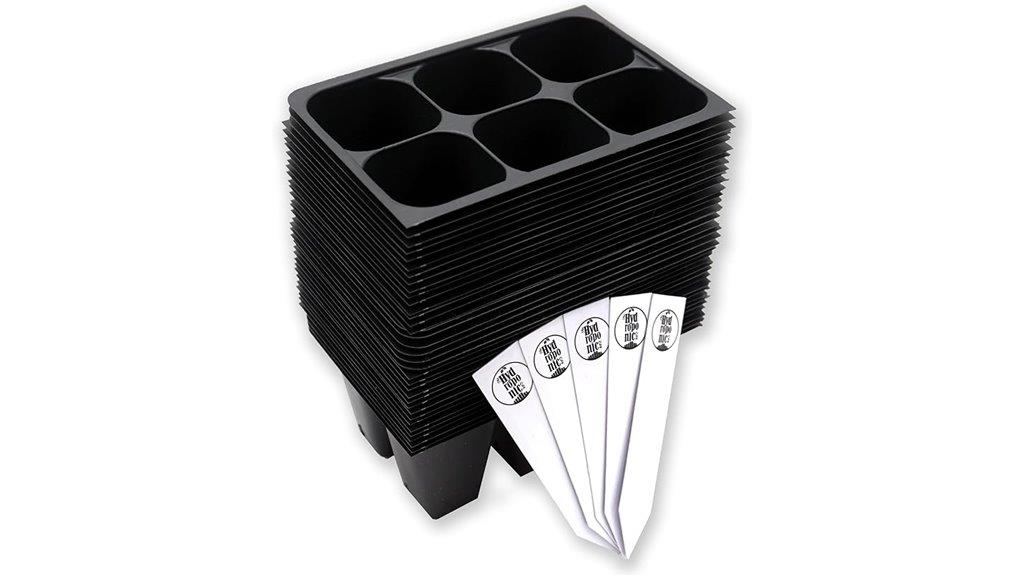
For gardeners seeking a reliable solution to nurture a large number of seedlings, the Hydroponic City Seed Starter Trays (216-Cell) stand out as a top choice. These trays, featuring 36 individual trays with 6 cells each, help promote healthy root development in a compact design. I love their versatility; they work well for flowers, herbs, and vegetables. The drainage slits prevent overwatering, ensuring ideal moisture levels. Plus, with a lightweight design and durable materials, they're perfect for sustainable gardening. Just keep an eye on soil types to prevent drying out. Overall, they're a fantastic addition to any gardener's toolkit!
Best For: Gardeners looking for an efficient and versatile solution to start a large number of seedlings for flowers, herbs, and vegetables.
Pros:
- Promotes healthy root development for robust seedling growth.
- Durable construction allows for reusability, supporting sustainable gardening practices.
- Strategically placed drainage slits help maintain optimal soil moisture and prevent overwatering.
Cons:
- Some users report that the trays may cause soil to dry out with certain soil types.
- Concerns about fine plastic strands from drainage holes may raise issues regarding microplastic contamination.
- Best suited for smaller seedlings, which may limit use for larger plants.
10 Plant Growing Trays for Seedlings and Indoor Gardening

Choosing the right plant growing trays can greatly enhance your seed starting experience, especially if you're venturing into indoor gardening or cultivating microgreens. I've found that the 10 plant growing trays, measuring 20 x 10 inches, are perfect for this purpose. Their shallow depth is ideal for delicate seedlings, allowing for effective bottom watering. Plus, they're stackable, which maximizes my growing space. While they're made from durable, food-safe plastic, I recommend using two trays together for added strength. Overall, these trays offer great value and functionality, making them a fantastic choice for any indoor gardening enthusiast!
Best For: Indoor gardening enthusiasts and those starting seeds or growing microgreens who need a versatile and space-efficient solution.
Pros:
- Versatile Design: Suitable for various plants including microgreens, herbs, and sprouts, allowing for diverse gardening options.
- Stackable: Maximizes growing space, making it easier to manage multiple trays in a limited area.
- Durable Material: Made from food-safe plastic that is reusable for multiple seasons with proper care.
Cons:
- Thin Plastic: Some users report concerns about the trays being thinner than expected, potentially leading to durability issues.
- Shipping Concerns: Instances of damage during shipping have been noted, indicating potential packaging and delivery challenges.
- Sturdiness Variability: Mixed reviews on sturdiness compared to other brands may lead to uncertainty for potential buyers.
Mr. Pen Plastic Growing Trays (5 Pack, 17×10)
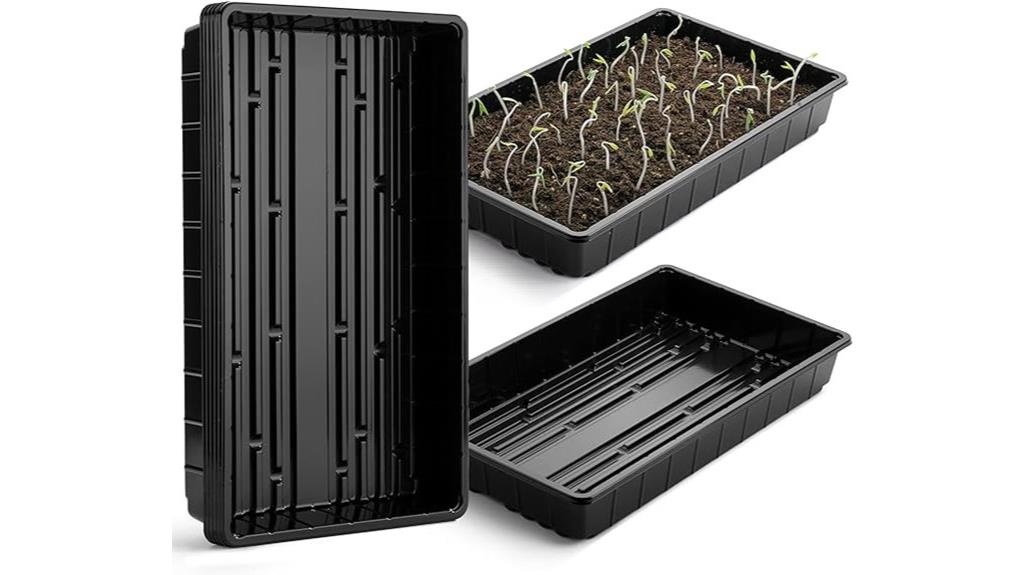
When it comes to starting seedlings or growing microgreens, Mr. Pen Plastic Growing Trays are a fantastic choice. This 5-pack, each measuring 17 x 10 inches, is made of sturdy, lightweight plastic that's easy to clean. I love how the raised edges keep everything contained, making my gardening experience tidier. These trays work perfectly with heat mats and humidity domes, so I can boost germination rates. Plus, they're stackable for convenient storage. With a solid rating of 4.5 stars, I've found they offer great value and reliability for healthy plant growth. You won't be disappointed!
Best For: Gardeners looking for a reliable and versatile solution for starting seedlings and growing microgreens.
Pros:
- Durable and lightweight plastic construction allows for easy handling and cleaning.
- Raised edges effectively contain soil and water, minimizing spills and mess.
- Stackable design makes storage convenient, saving space when not in use.
Cons:
- Some users have reported issues with flimsiness of the plastic material.
- A few customers experienced leakage, which can affect the growing process.
- Limited color options, as the trays are only available in black.
MIXC Seed Starter Tray Kit with Humidity Dome (10 Packs, 120 Cells Total)

The MIXC Seed Starter Tray Kit with Humidity Dome is an excellent choice for any gardener enthusiastic to kickstart their planting journey. With 10 trays and 120 cells, it creates a mini greenhouse effect perfect for germinating various seeds. I love the adjustable vents that let me control humidity and temperature, while the drainage holes help prevent root rot. The clear lids make monitoring easy, and the durable plastic guarantees these trays last through multiple seasons. Though some users faced lid fitment issues, I've found its performance and ease of use make this kit a valuable addition to my gardening arsenal.
Best For: The MIXC Seed Starter Tray Kit is best for novice and experienced gardeners looking to efficiently germinate a variety of seeds.
Pros:
- Durable construction allows for multiple growing seasons without wear.
- Adjustable vents provide optimal humidity and temperature control for seed germination.
- Clear lids enable easy monitoring of seedlings while maintaining humidity levels.
Cons:
- Some users experienced issues with securing the lids properly.
- The lightweight design may require careful handling to avoid tipping.
- Limited to starting seeds; not suitable for growing mature plants.
Burpee Greenhouse Indoor Starting Kit for Herbs, Flowers, and Vegetables
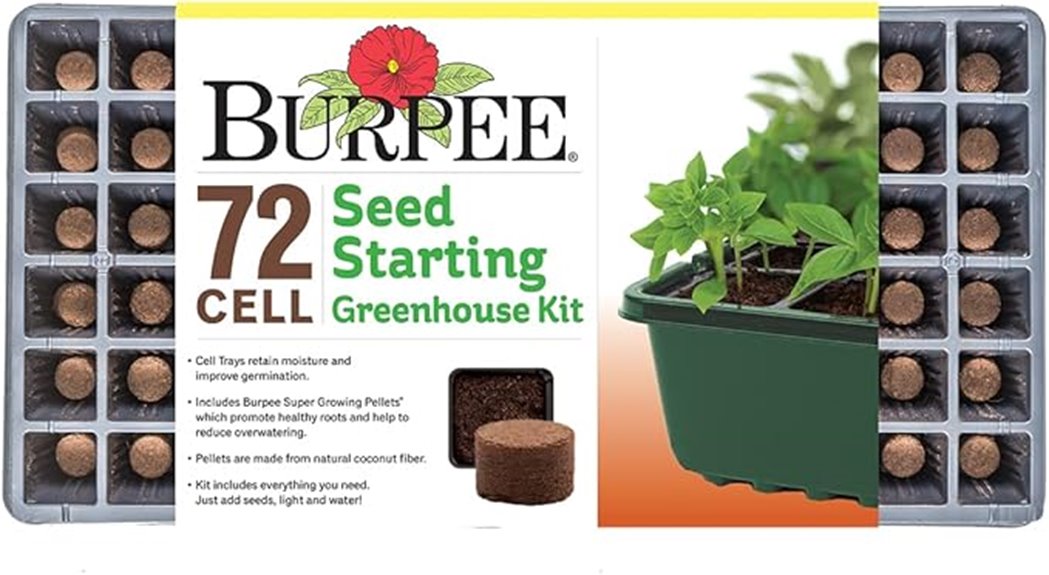
For anyone looking to cultivate a diverse garden of herbs, flowers, and vegetables, the Burpee Greenhouse Indoor Starting Kit stands out as a top choice. This kit includes two 36-cell trays, a water reservoir, and 72 super growing pellets, allowing me to grow up to 72 seedlings. I love the plant-o-gram diagrams and markers for easy organization. After soaking the pellets and ensuring the soil's moisture, I plant my seeds with confidence. While some users prefer potting mix, I've found success with the provided pellets. Overall, Burpee's commitment to quality makes this kit a reliable option for aspiring gardeners.
Best For: Aspiring gardeners looking to start herbs, flowers, and vegetables indoors with an organized and efficient system.
Pros:
- Includes everything needed to start growing 72 seedlings, such as planting trays, growing pellets, and a greenhouse cover.
- Features plant-o-gram diagrams and markers for easy tracking and organization of seedlings.
- Burpee's long-standing commitment to quality ensures healthy seeds and reliable gardening supplies.
Cons:
- Some users report that the included growing pellets may not yield as good results as traditional potting mix.
- Durability issues have been noted with the plastic trays and the flexibility of the dome cover.
- Users recommend bottom watering to avoid disturbing seedlings, which may require extra care and attention.
Bonviee Seed Starter Tray Kit (10 Packs, 120 Cells)
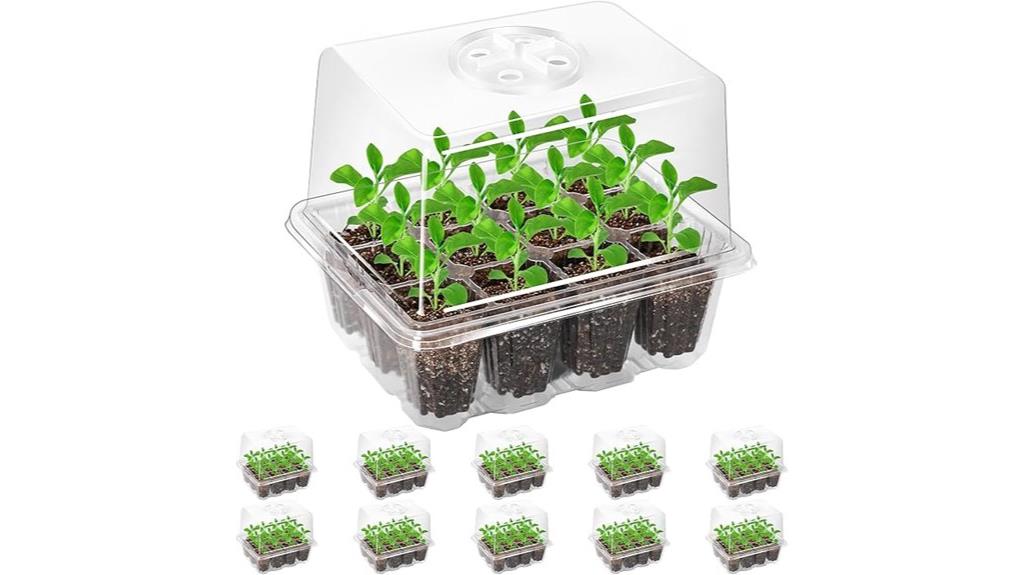
If you're looking for an effective way to kickstart your gardening journey, the Bonviee Seed Starter Tray Kit is a fantastic choice. With 10 packs and 120 cells, it offers ample space for your seedlings. I love the elevated lids that promote healthy growth and the transparent design lets me monitor root development easily. Plus, the ideal drainage prevents waterlogging, keeping my plants healthy. It's eco-friendly too, as I can reuse and wash the trays. While some lids may not fit perfectly, the overall satisfaction and high germination rates make this kit a top contender for indoor gardening.
Best For: Gardening enthusiasts and beginners looking to efficiently start their seedlings indoors.
Pros:
- High germination rates of up to 95%, ensuring successful plant growth.
- Eco-friendly design allows for easy reuse and cleaning between planting seasons.
- Transparent construction and elevated lids enable effective monitoring of root development.
Cons:
- Some users report that the lids do not secure tightly, which can impact humidity retention.
- Trays may be perceived as smaller than expected, limiting space for larger seedlings.
- A few users experienced cracking of lids, potentially affecting durability.
72 Cell Seed Trays for Germination (10-Pack)
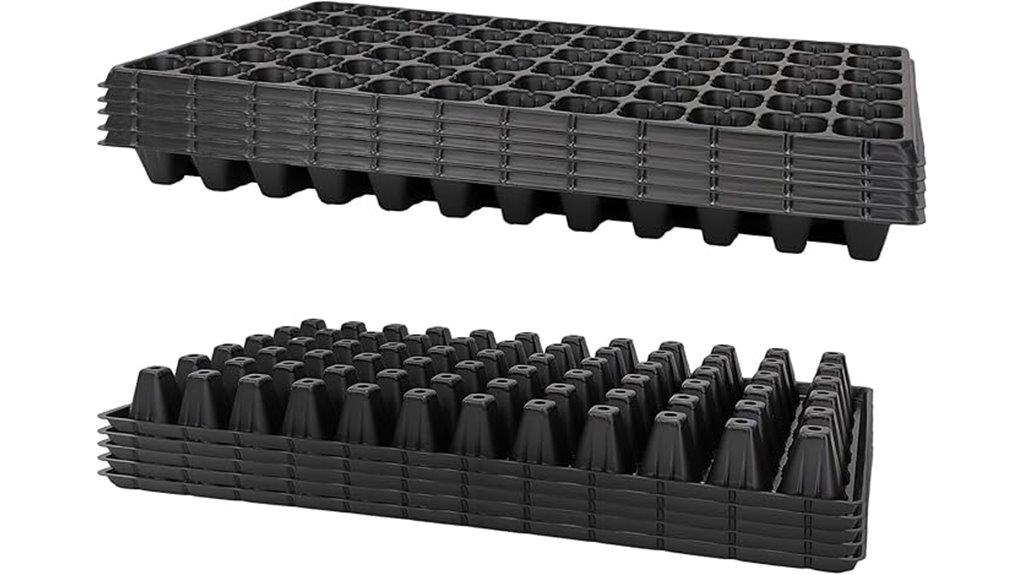
Looking for a reliable solution to kickstart your gardening journey? The 72 Cell Seed Trays for Germination (10-Pack) are just what you need. Measuring 21×11 inches and crafted from thickened plastic, these trays are both durable and reusable. Each cell promotes excellent water and nutrient absorption, while the top drip port and bottom holes maintain healthy roots. Whether you're growing vegetables, herbs, or flowers, these trays fit perfectly in 1020 flat trays, making them ideal for limited spaces. With an average rating of 4.5 stars, they've proven effective for gardeners like you. Let's get those seeds sprouting!
Best For: Gardeners looking for an efficient and space-saving solution to start a variety of plants, from vegetables to flowers.
Pros:
- Durable thickened plastic material ensures longevity and resistance to warping.
- Designed with optimal water and nutrient absorption, promoting healthy seed growth.
- Compatible with standard 1020 flat trays, making them ideal for limited space gardening.
Cons:
- Some users report variability in quality, with a few finding trays to be flimsy.
- Average rating indicates mixed experiences, suggesting not all users are satisfied.
- Limited height may not be suitable for larger seedlings or certain plant types.
Epic Gardening Reusable Seed Starter Tray (16 Cell)

The Epic Gardening Reusable Seed Starter Tray (16 Cell) stands out as an ideal choice for gardeners who value sustainability and durability in their planting tools. Made from 100% recycled, UV-resistant plastic, it's designed to last. The unbreakable structure features large finger holes for easy seedling removal, and air pruning slots promote healthy root growth. I love how it fits standard nursery trays, allowing for a convenient setup. Plus, I can easily remove individual trays as seedlings mature, skipping the hassle of pricking out. Overall, I find it a fantastic investment for nurturing strong, healthy plants.
Best For: Gardeners who prioritize sustainability and need a durable, user-friendly seed starting solution.
Pros:
- Unbreakable, reusable design made from 100% recycled plastic ensures long-lasting use.
- Air pruning slots promote healthy root development, resulting in stronger seedlings.
- Fits standard nursery trays for a convenient 256-cell setup, making it easy to manage seedlings.
Cons:
- Some users have expressed concerns about the tray size, indicating a need for clearer dimensions in product descriptions.
- Limited size may not accommodate all seed types, which could be a drawback for certain gardeners.
- A few customers reported minor challenges with seedling removal despite the large finger holes.
Factors to Consider When Choosing Seed Trays

When I choose seed trays, I always consider the material quality and whether they'll last through multiple seasons. The cell size options and drainage features also play a big role in promoting healthy growth. Plus, it's important to think about how well the trays work with other gardening accessories I might use.
Tray Material Quality
Choosing the right seed tray material is essential for successful gardening. I've found that thicker plastic trays offer great durability, resisting warping and allowing for long-term reuse. Opting for BPA-free plastic is important, as it guarantees no harmful chemicals leach into the soil or my plants. Sturdy materials also prevent cracking and leakage, which is critical when I'm transporting filled trays. I appreciate trays designed with UV resistance, as they extend the lifespan when exposed to sunlight, especially for outdoor gardening. Overall, thicker trays provide better structural integrity, protecting my seedlings during handling. By prioritizing material quality, I set my plants up for a healthier, thriving start.
Cell Size Options
Selecting the right cell size for seed trays can greatly influence the success of your gardening efforts. Typically, cell sizes range from 1.5 inches to over 2 inches in diameter. Smaller cells are perfect for herbs and flowers, while larger ones work better for vegetables. Don't overlook cell depth, either; deeper cells promote root growth, allowing plants to absorb nutrients more effectively and reducing watering frequency. Consider the tray's capacity, too—common configurations like 36, 72, or 216 cells cater to various gardening needs. Choosing the right size can also impact transplanting success; smaller cells may cause root entanglement, while appropriately sized cells support healthier roots. Ultimately, the right cell size contributes to robust plant development and quicker germination.
Drainage Features Importance
While I'm excited about starting my plants, I can't overlook the importance of drainage features in seed trays. Proper drainage prevents overwatering, which is essential for maintaining healthy root systems and reducing the risk of root rot. I always look for trays with drainage holes, as they allow excess water to escape, ensuring my seedlings get just the right moisture without becoming waterlogged. Effective drainage also promotes soil aeration, helping roots absorb oxygen vital for robust growth. I find trays with strategic drainage slits particularly helpful, as they maintain ideal moisture levels. Plus, incorporating a top-drip port can enhance water distribution, further improving the drainage system. This way, I'm setting my plants up for success right from the start!
Reusability and Durability
After ensuring adequate drainage in my seed trays, I turn my attention to reusability and durability. I've found that high-quality trays made from thickened plastic can last multiple planting seasons without degrading. These durable trays withstand exposure to sunlight and moisture, which is essential for long-term gardening success. Additionally, many feature excellent design elements like drainage holes and aeration systems that promote healthy root growth and prevent overwatering. I appreciate those engineered for easy cleaning and storage, as they enhance longevity and save money over time. User feedback often highlights that sturdier trays can support heavier plants without buckling, making them a reliable choice for various gardening applications. Investing in durable trays truly pays off in the long run.
Compatibility With Accessories
When I'm choosing seed trays, I always consider how well they'll work with my other gardening accessories. It's crucial to pick trays compatible with heat mats and humidity domes, as they really boost germination success. I prefer trays that fit standard sizes, like 1020 growing trays, for easy integration into my setup. Additionally, I look for trays that support bottom watering systems, maintaining consistent moisture levels. Stacking or nesting designs are a must for efficient storage alongside my other tools. Finally, I always check the drainage features to confirm they align with my watering methods and chosen growing medium. This compatibility makes my gardening experience smoother and more productive.
Seedling Capacity Considerations
Choosing the right seedling capacity for your trays can greatly impact your gardening success. The number of cells in a tray—like 36, 72, or even 216—determines how many varieties you can start at once. If you want to maximize efficiency, a larger capacity tray is your best bet. Keep in mind the size of the individual cells: 1.5 inches in diameter works well for herbs and flowers, while larger cells are necessary for vegetables. Also, consider the total volume of soil each cell holds, as it affects nutrient availability and water retention. Finally, make sure the tray dimensions fit your gardening space for proper light exposure and easy maintenance.
Design for Airflow
Since proper airflow is vital for healthy seedlings, it's important to take into account the design features of seed trays that promote ventilation. Trays with adjustable vents are a game changer, allowing me to customize airflow and manage humidity levels effectively. I also look for air pruning slots or holes at the bottom, which help prevent root circling and encourage a robust root system. Another great option is trays with a clear top or dome; they maintain humidity while still allowing airflow, creating the perfect environment for germination. Finally, I always check for effective drainage systems in the design. They prevent waterlogging and guarantee balanced moisture levels, both essential for promoting healthy seedling development.
Ease of Use
While I want my seedlings to thrive, I also need the process to be as simple as possible. That's why I look for seed trays with adjustable humidity domes; they help manage moisture levels effectively. Clear lids are another must-have for me, as they let me monitor growth without disturbing the seedlings. I also prefer trays with drainage holes to prevent overwatering, which simplifies my plant care routine. Lightweight and stackable designs make transporting and storing trays a breeze. Ultimately, I appreciate trays that come with labeled plant markers, as they make organizing and identifying seedlings effortless. With these features, I can focus more on nurturing my plants and less on managing the process.
Frequently Asked Questions
How Do I Clean and Maintain My Seed Trays?
Cleaning and maintaining my seed trays is pretty straightforward. I usually start by rinsing them with warm water to remove any soil or residue. If they're really dirty, I scrub them gently with a soft brush and a mild soap solution. After that, I rinse thoroughly to avoid any soap residue. Once they're clean, I let them dry completely before storing them away. This way, I make sure they're ready for the next planting season!
Can I Reuse Seed Trays From Last Season?
Absolutely, you can reuse seed trays from last season! It's like finding a hidden treasure in your gardening supplies. Just make sure to clean them thoroughly to avoid any lingering pests or diseases. I usually soak them in a mixture of water and vinegar, which works wonders. After that, I rinse and let them dry completely before using them again. Trust me, reusing trays saves time and money while keeping my garden thriving!
What Materials Are Seed Trays Typically Made From?
When I think about seed trays, I find they're usually made from a few common materials. Most often, you'll see plastic, which is lightweight and durable. I also come across biodegradable options made from materials like peat or coconut coir, which I love for being eco-friendly. Some trays even use metal or wood, giving a rustic vibe. Each material has its pros and cons, so it's worth considering what suits my gardening style best.
How Do I Prevent Mold in Seed Trays?
Imagine a lush garden, vibrant with life, but suddenly, a fuzzy mold creeps over my seedlings. To prevent this, I keep my seed trays clean and dry. I guarantee good air circulation by spacing them out and using a fan if needed. Watering them carefully, I avoid soaking the soil, letting it dry slightly between sessions. I also use sterile soil to give my plants the best chance to thrive without mold's unwanted presence.
What Is the Best Way to Label Seedlings in Trays?
When it comes to labeling seedlings in trays, I've found a few simple methods work best. I often use wooden popsicle sticks or plastic labels, writing the plant name and date with a waterproof marker. I also love color-coding my labels to easily identify different varieties. Another handy tip is to keep a garden journal, where I jot down details about each tray. This way, I never lose track of my precious seedlings!
Conclusion
In the garden of life, choosing the right seed trays is like selecting the finest soil for your dreams to take root. With the options laid out before you, it's time to sow the seeds of your gardening journey. Each tray is a vessel of potential, waiting to cradle your ambitions and nurture your plants toward the sun. So, grab your favorite, and let's watch as your garden flourishes into a vibrant tapestry of growth and color!
